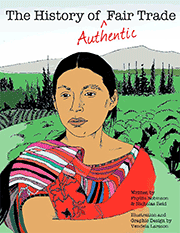It’s a cold, blustery day here in southeastern Massachuetts and the five-vehicle caravan which is heading down Route 28 towards Buzzard’s Bay is packed with Equal Exchange staff bundled up in our hoodies, head scarves, boots and rain gear. It’s a field trip and we’re visiting some of our newest farmer partners… but this time no passports, visas, or airline tickets are needed. We’re visiting Monika and Keith Mann, the farmers who grow our organic dried cranberries, one of the healthy snack products in our Domestic Fair Trade program; and their farm is right here less than 40 miles south of our facilities.
Many in the group have never visited a cranberry bog before and today seems like the perfect time to do so. Well, maybe not so perfect for Monika and Keith who are smack in the middle of the harvest – but an ideal moment for us to see the bogs full of ripe berries, hopefully get our feet wet learning how to pick (there’s a dry and wet picking depending on whether the cranberries will eventually be sold as “fresh” or “processed”), and then observing how the farmworkers sort and pack the berries.
Equal Exchange launched our Domestic Fair Trade program in 2007 to support small farmers in the U.S. who face many of the same challenges as the farmers we work with internationally: market access, credit, economies of scale, technical support, and government policies and subsidies that favor agri-business. It’s slow going, but we’re very proud of the work we’ve done to support small scale almond, pecan, and cranberry growers in the U.S. and to help inform and educate consumers about the challenges and importance of small scale farming throughout the world.
Monika brought us on a tour of some of their organic bogs. We saw a “baby bog” that was just renovated and replanted this year, and then several that were “adolescent” and finally, the “adult” bogs; the entire renovation process takes five long years of constant maintenance and upkeep. They must be hand weeded until the cranberry vines are solidly vined in. The two-year old bog you see on the left was in the process of being hand weeded while we were there. Monika says it takes 10 days for a team of five or six folks to weed a bog this size. The bogs also have to be flooded, iced, and sanded and according to Monika, this is an extremely labor and resource-intensive process. It’s not uncommon for them to have to get out of bed in the middle of the night and make the rounds of the bogs to control the water temperature during the cold months. “It’s really easy to kill a bog by not putting down the ice properly,” Monika tells us. It costs approximately $20,000/acre to renovate a cranberry bog.
Monika is extremely knowledgeable – and deeply passionate – about organic farming and she was incredibly patient and good natured answering all of our questions about production from farm maintenance to species variation. We even ate a few cranberries in each bog to see if we could detect subtle variations in taste… by the way, how many of you have ever broken open a cranberry to view its inside? Pretty beautiful, eh? Kind of looks like a pomegranate….
Next, we trooped inside the screening house, built in the 1940’s which has only been back in use these last dozen or so years, since they’ve begun doing organic production. There, we saw the many steps involved in cleaning, sorting and packaging the berries. We’ll post a video soon so you can all watch the different pieces of machinery; it was really wild. Meantime, here’s a before and after photo of the berries (kind of funny how closely they resemble coffee when it’s in the cherry about to be depulped):
We took a break for lunch and while we waited for our meals, Sarah invited us to do a “blind tasting” of the cranberries. She put out two cranberry sauces that she had made the night before; one was made from organic cranberries from one of the bogs we had just toured and the other was from conventional cranberries. She also put out a plate of dried cranberries; one was our very own product and the other was from a competitor. She asked us to jot down the characteristics of each, our preferences, and to try to guess the origin of the samples. I won’t tell you how many of us correctly identified the organic from the conventional and ours (from the Mann farmers) from the competition, but I will tell you how impressed I was with Danielle, who not only guessed both samples correctly, but did so without a flicker of hesitation, defending her opinions with the certainty of a professional… Right on Quality Department!
Finally, we headed over to Wareham where Monika’s husband Keith was doing the very last “dry picking” of the season. There was a lot of confusion about dry and wet picking but by the end of the afternoon, I think we finally had it right. The berries that are dry-picked end up as wet berries (sold “fresh”) and the berries that are wet-picked end up as dried berries (sold “processed”, for example, dried, juice, sauce, etc.)
Keith’s passion matched what we had already seen in spending the the morning with Monika. His knowledge comes from years of doing this work. In fact, Keith’s family have been cranberry farmers for generations; three on his father’s side and four on his mother’s! He told us a very moving story about how when he was five years old, his father asked him if he wanted to be a cranberry farmer. “Because if you do,” his father told him, “this farm is yours. And if you don’t, that’s the end of the farm.” He said his father probably didn’t even remember the conversation, but it had a tremendous impact on him and he has felt that responsibility his whole life. He then went on to tell us how difficult it had been when the price of cranberries had crashed and how he couldn’t “make a salary”, nor could he get another job. Today, however, prices have improved and while the round-the-clock work continues, Keith seemed full of pride and still deeply engaged discovering new farming techniques, sustainable practices, and processing innovations.
By the end of the day, the rains were coming down hard and we weren’t able to try our hand at cranberry picking. We’ll have to visit again, perhaps during next year’s harvest. We thanked Keith for spending so much time with us, especially during this incredibly busy time of year. Monika had already taken her leave. She’s home schooling her 13-year old daughter and had to get back to the house. Before she left, she thanked us as well. “We’ve always been inspired by Equal Exchange,” she said, “you have integrity and a clear passion for the work you do. And if you can do for small, local farmers here in the U.S. what you’ve been doing for farmers internationally, that would be really be impressive.”
We’re trying our best. And with farmer partners like the Manns and all the other relationships we’ve built through these years, farmers and consumers alike, it’s hard not to find the inspiration to try even harder.












